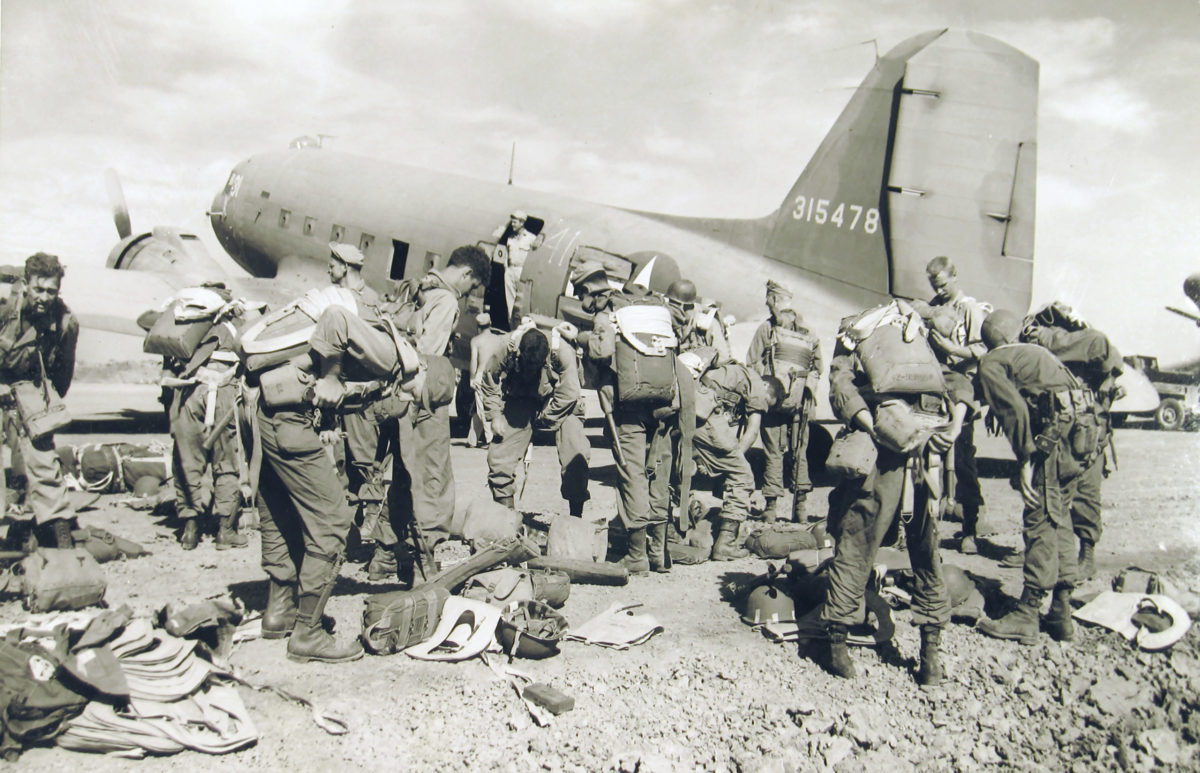As dawn lightened the skies on January 31, 1945,a naval flotilla of more than a hundred vessels held station in the dark waters off Nasugbu Beach on the Philippine island of Luzon. The convoy was poised 40 miles south of Manila, ready to land 6,462 troopers of the 11th Airborne Division. But first came the air strikes: 18 twin-engine Douglas A-20 Havoc medium bombers zoomed over Red Beach, chewing up suspected Japanese positions with their forward-mounted .50-caliber machine guns. Nine Lockheed P-38 Lightning fighters followed them in, repeating the performance.
At 7:15 a.m., two American destroyers rotated their 5-inch guns into position and began hurling 55-pound shells at the shore, tearing apart the tree line in a series of shattering explosions. Simultaneously, rocket-equipped landing craft angled to align their rudimentary launchers with the landing beach. The rockets lifted off with deafening whooshes as paired salvos arched across the pink sky.
An hour into the bombardment, boatswains gunned their landing craft toward the beach to land the first wave of infantry. Intelligence suggested there were 7,000 Japanese soldiers south of Manila, with 500 guarding the beach itself. By this point the battle for Luzon had been raging for three weeks, so keeping track of enemy units was difficult at best. Ten days into the campaign General of the Army Douglas MacArthur had complained about the slow pace of his field commander, Lieutenant General Walter Krueger, whose Sixth Army was plodding south toward Manila despite light enemy resistance. To spur Krueger forward, MacArthur authorized a second landing south of the capital city. The operation, code-named MIKE VI, fell to Lieutenant General Robert L. Eichelberger, commander of the Eighth Army. Eichelberger proposed to amphibiously land the 11th Airborne’s two glider infantry regiments and then airdrop the division’s parachute regiment farther inland a few days later.
The second landing was likely spurred by MacArthur’s desire to use the rivalry between his two army commanders to hasten Manila’s capture. There was a simmering antagonism between the two men, and Eichelberger, who believed MacArthur was “disgusted” by Krueger’s slow progress, referred to the Sixth Army commander as “old Molasses in January.” Eichelberger’s own Eighth Army was a skeleton organization, slimmed down from its normal complement of several divisions to just the undersized 11th. With a total manpower of just over 8,300, the 11th was roughly sixty percent the size of a standard infantry division. Additionally, the navy provided barely enough ships to support the landing, and the Air Corps had scraped together just 50-odd transport planes, a third of what was needed to drop the entirety of a regimental combat team in a single lift. Eichelberger privately referred to his command as “Task Force Shoestring.”
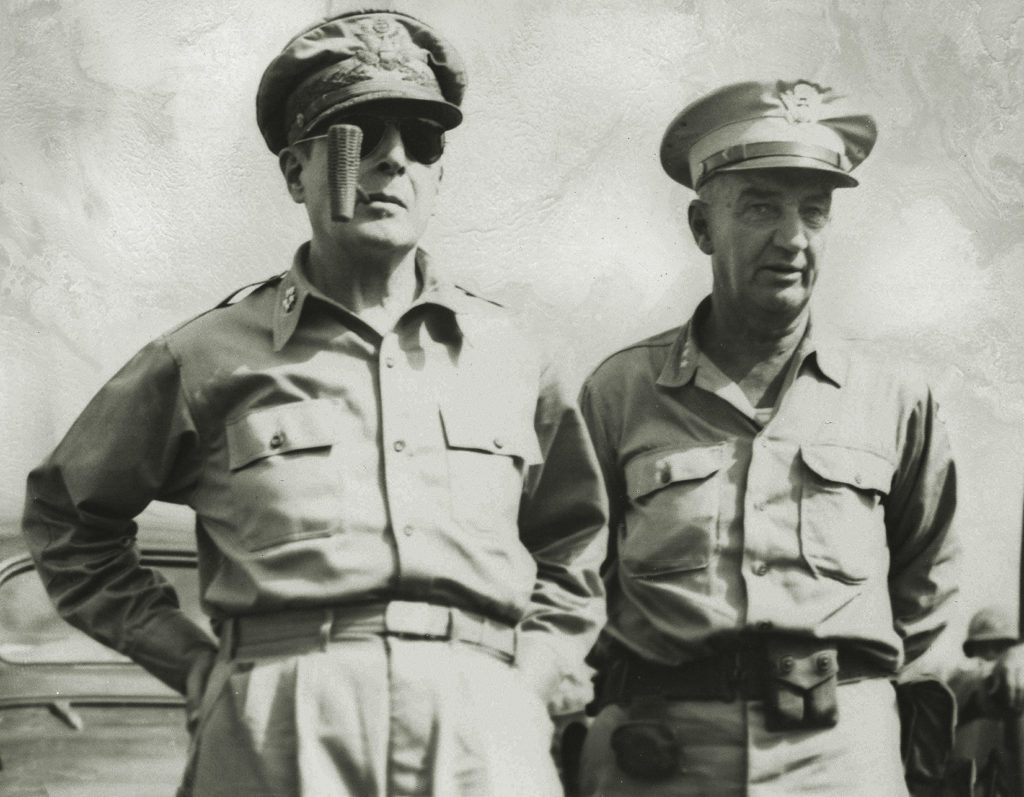
Major General Joseph M. Swing, the 11th’s 50-year-old commander, begrudgingly supported the plan, “Well, half a loaf is better than none, I suppose…. We’re going in half airborne and half amphibious,” he wrote to his father-in-law. “As you can imagine, it’s an end run with a forward pass.”
This was Swing’s second campaign of the war. He and his division had already fought their way through the jungles of Leyte as part of MacArthur’s triumphant return to the Philippines in October 1944. While Swing was a relative newcomer to the Pacific theater, he had served almost 30 years in uniform, having received his West Point commission in 1915 and serving in General John “Black Jack” Pershing’s 1916 expedition into Mexico as his first assignment. There he witnessed Pershing’s propensity for leading from the front—a trait he took to heart. In 1917, Swing served as a captain with the 1st Infantry Division in World War I, where his experiences in the mire of the trenches taught him that static positions and frontal assaults were no way to win a war. By 1941, Swing had earned the star of a brigadier general and was Major General Matthew B. Ridgway’s artillery officer when the 82nd Infantry Division transitioned into the army’s first airborne division. In February 1943, with a second star on his collar, he was assigned to command his own airborne division.
The 11th’s landing at Nasugbu was technically a “reconnaissance in force” to determine the “Japanese strength, deployment, and intentions.” The exact goals remained vague—Eichelberger labeled them “indefinite plans,” and he and Swing agreed to exploit the ambiguity and get into the main action. Their field orders advised commanders to be “prepared to advance north” after seizing their initial objectives. “North” was a veiled reference to Manila.
Swing landed on Red Beach with the third wave. As he and his staff hustled out of their landing craft, several Japanese machine gun bursts erupted from the left flank. Swing’s assistant division commander, Brigadier General Al Pierson, was hit in the stomach by what felt like a baseball bat. Miraculously, the bullet struck his army-issue compass. The instrument would never point north again, but it had saved Pierson’s life. As the staff lay pinned down in the dunes, bullets stitched the beach, and random artillery shells exploded in geysers of sand and shrapnel. Lieutenant Colonel Bill Crawford, Swing’s logistics officer—the “G-4”—announced he was going to crew the belt-fed machine gun on their landing craft to return fire. Waiting for a lull, he readied for a sprint. When Crawford got to his feet, Swing grabbed his ankle and tripped him. “You keep down,” Swing yelled. “I need a G-4!”
The heaviest fire came from several machine guns nested in a red-roofed building on the left flank. Not far from Swing, a naval gunfire team radioed sailors offshore and within minutes rockets tore into the building, setting it and several surrounding structures ablaze. The guns fell silent.
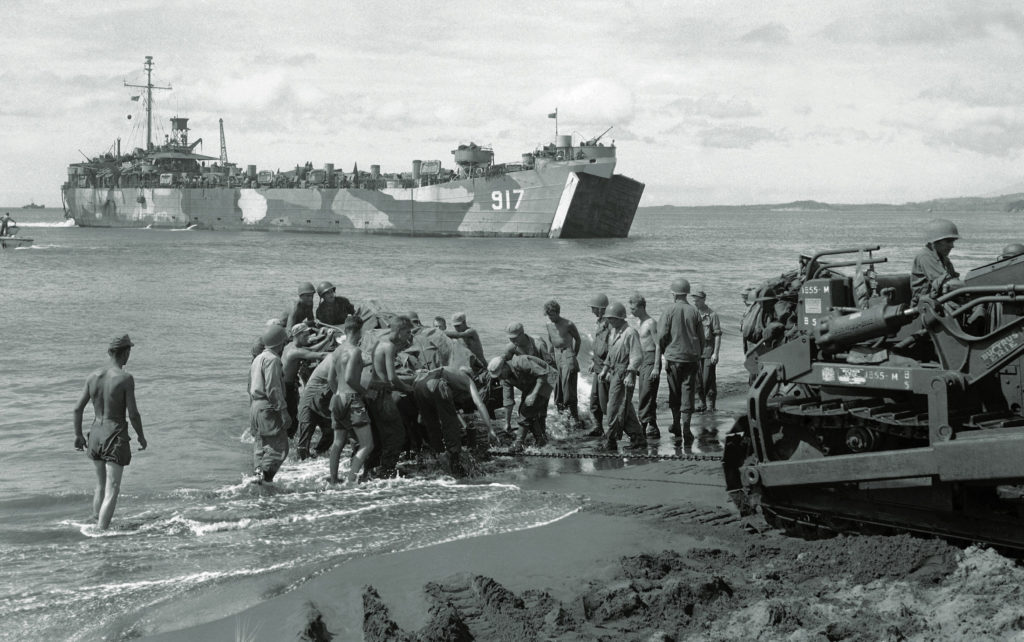
By 9:45 a.m., glider troops were fanning out to secure the beachhead while Swing and his staff set up their command post in a one-story school building in Nasugbu’s town plaza.
The primary objective, Tagaytay Ridge, where the paratroopers would drop, lay 24 miles inland. Eichelberger urged speed, but he needn’t have worried. Swing already had the commander of the 188th Glider Infantry Regiment, 44-year-old Colonel Robert “Shorty” Soule, on the move. The glidermen headed out of town, weaving through crowds of jubilant Filipinos celebrating the end to three years of Japanese occupation. Once past the gleeful mobs, they moved briskly in single-file columns on each side of the one-lane gravel road.
The primary artery to Tagaytay led past open farmland punctuated by pockets of thick, lush vegetation. The sun beat down on the men’s steel helmets. With full packs and rifles slung or at the ready, they put one dusty boot in front of the other. Sweat dripped into their eyes and gravel crunched under their feet. It all combined into a monotony that made the weight of their equipment impossible to ignore. Glancing up from their march, they would have seen the distant ridgeline that was their destination—and where the enemy lay waiting.
Five miles inland the lead platoon shuffled downhill toward the Palico River, intent on securing the 200-foot steel-trussed bridge that spanned the river’s 80-foot-deep gorge. On the far side, the men spotted a Japanese squad preparing to demolish the bridge. The Americans’ first volley of rifle fire felled six saboteurs and scattered the rest.
Soule’s men marched on, huffing out of the coastal plains and ascending into the mountains toward Tagaytay. They kept hiking after dark, taking advantage of the moonlight. At midnight, after slogging inland for more than 12 hours, the lead battalion paused to allow fresh troops to take point. They pushed through sporadic rifle fire until they finally stopped to rest at 4:00 a.m. They were back on their feet two hours later.
At daybreak on February 1, the rattle of machine guns sent the point squad diving for cover. Now 11 miles inland, the road threaded uphill through a draw formed by three mountains. The left was dominated by 2,100-foot Mount Cariliao, with the sharp rise of Mount Aiming at its base. One of the troopers described Aiming as “a thimble at the base of an overturned teacup.” On the right, Mount Batulao rose to 2,700 feet. The heights were covered in thick scrub and provided a commanding view of the road. Bullets cracked in from machine gun positions on all three mountains. Japanese observers, eyeing the Americans through binoculars, called down artillery and mortars. As the glidermen crawled for protection, shells whistled into pre-sighted points up and down the gravel road.
While Soule’s mortar teams thumped out high-explosive rounds to suppress the incoming fire, cannoneers wheeled up heavier guns: four 75mm pack howitzers of the 457th Parachute Field Artillery Battalion. The crews, ignoring ricocheting bullets, muscled their gun tubes into position and aimed them by looking over the barrels as though they were shotguns. Each successive WHOOOOM! of a howitzer shattered a distant machine gun nest. But rifle fire still snapped overhead and the artillery shells raining down forced Soule’s lead battalion to withdraw.
With the sun well up, circling Havocs streaked out of the sky, seeking enemy howitzers and pummeling the hilltops with bombs and strafing fire. While the Japanese hunkered down, Soule’s men attacked. Captain Raymond F. Lee led a company through a steep gorge on the north side of the highway and then on the ascent of Aiming. Their close-quarters assault with rifles, grenades, and bayonets cleared the summit and captured a 105mm howitzer in the process. Lee and his men rolled Japanese corpses out of foxholes so they could use the dugouts for their own defense. Lee’s men spent the afternoon fending off several banzai attacks, and in between the Japanese pounded them with artillery.
Simultaneously, on the right flank, troopers cleared enemy positions up to the base of Mount Batulao. The day’s work resulted in 91 enemy dead and several captured howitzers, but it came at a heavy cost: 16 dead Americans and 44 wounded.
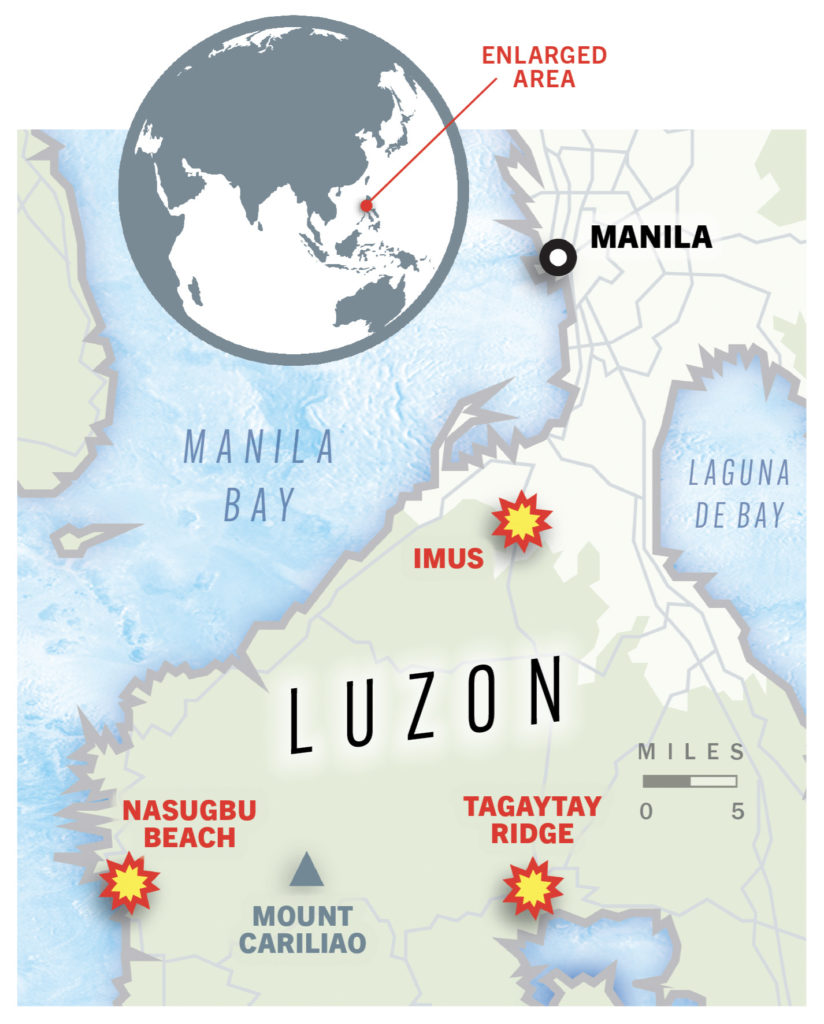
Friday, February 2, dawned with clear skies and good visibility, perfect weather for airstrikes and artillery barrages. The Havocs and howitzers paved a path and by midday the troopers had swarmed past three Japanese anti-tank ditches to sack a command post littered with bloody medical supplies and nearly 100 tons of ammunition. The advance had been a modest two miles, but it was close enough to Tagaytay for Eichelberger and Swing to agree: the airdrop was on. Even so, the Japanese weren’t done. Artillery, mortars, and machine guns harassed Soule’s forward lines all night. Infiltrators crept through the inky jungle to assault artillery positions and forced the cannoneers to desert their guns before mustering to retake them.
The next morning, February 3, was the big push. Swing and his entourage were up front with the infantry who, after scarfing down a few bites of cold rations, pulled themselves out of their foxholes. It was time to go to work. They trudged forward to close on the last hill between them and Tagaytay.
An hour into their trek, a low, steady droning noise caught their attention. It came from an armada of 51 lumbering C-47s escorted by darting P-38s. As the first serial approached, the pilots found the ridgeline obscured by a low cloud bank. Fortunately, a break in the haze revealed the final checkpoint. The lead pilot, now assured of his position, led the following aircraft to the drop zone.
Paratroopers surged out the doors once the jump light glowed green. Weighed down with equipment, they tumbled more than jumped. One of them, Charlie Sass, recalled, “I carried double my weight out the door—two bandoliers, rockets, grenades, BAR clips, assorted firing devices, three days of K-rations, first aid packet, shovel, two canteens, plus chute, reserve, and me. The whole rig may have toted up to four hundred pounds.”
The trailing serials were still six miles short of the drop zone when either an equipment bundle was intentionally dropped or jarred loose or someone jumped early. In any event, troopers mistook the parachute canopy as the signal to jump. The resulting chain reaction was inevitable. First Lieutenant Randolph Kirkland remembered, “Our lead officer in the door had to make a quick decision. The planes were going much too fast, and we were certainly some miles from the true drop zone. He did what I would have done—he jumped.” Kirkland followed, holding a tight body position until he felt the reassuring jerk of his deploying chute. But exiting before the pilot slowed down meant a rough opening shock. Kirkland’s experience was typical of many. “My musette bag, with my poncho, C-rations and bourbon, disappeared into the clouds,” he said. “The grenades in my pockets joined them. The opening shock well-nigh knocked me out.”
The sky filled with parachutes as troopers descended into the cloud bank. Kirkland recalled, “[I] was rudely brought to reality when a palm tree whistled by me. It was a ground fog and not a cloud.”
Within minutes 886 troopers were on the ground but only 345 of these had landed on the planned drop zone—the rest were strung out four to six miles away. The men shrugged off their chutes, loaded their rifles, and scurried off to their assembly areas. Overhead the rumbling C-47s banked into their return route to pick up the second lift.
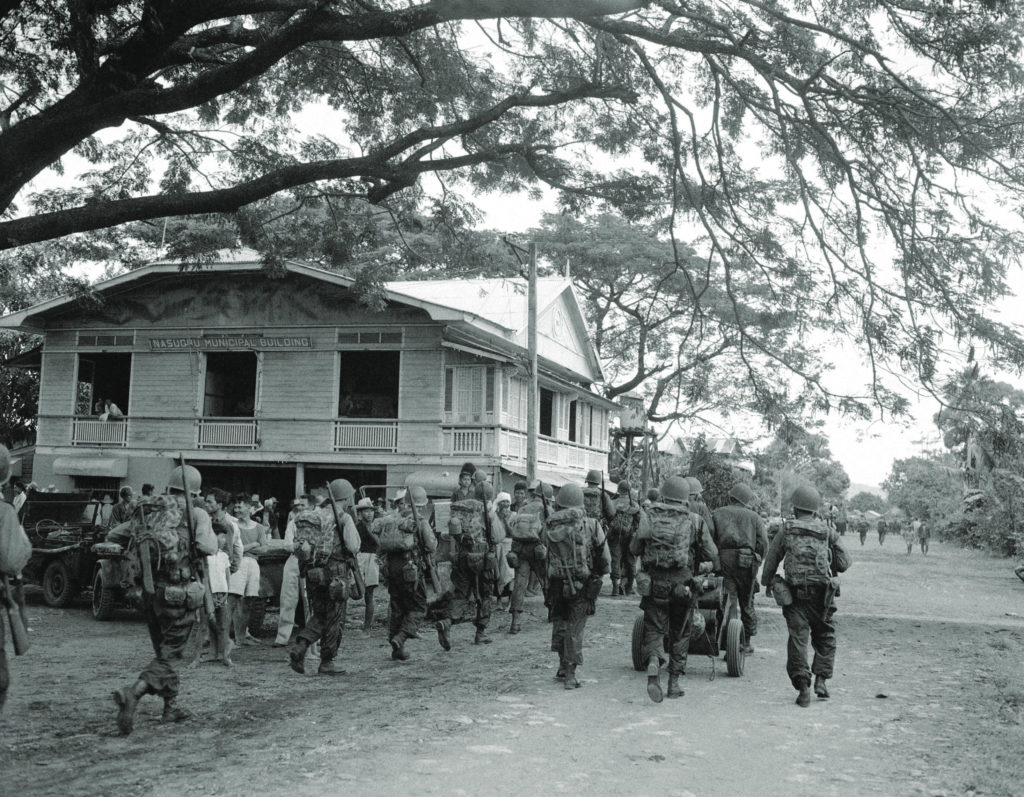
Soule’s glidermen made steady uphill progress toward the drop zone until 10:15, when 300 Japanese troops opened fire with rifles and machine guns. Explosions from the incoming artillery walked up the length of the American column.
In the vanguard, Eichelberger, Swing, and their contingent of high-ranking staff officers scrambled for cover. They were there to prod momentum, intent on making a smooth linkup with the paratroopers. A colonel sheltering near Swing was killed in the barrage along with seven other men. Twenty-one more were wounded, among them ‘Shorty’ Soule. Undaunted, he crawled half a football field back to his jeep while more shells whistled in. Soule’s driver, Pius Corbett, was under the jeep, shielding himself from flying shrapnel.
“Corbett, do you want to hand me that radio?” asked Soule.
“No, sir,” replied Corbett, “I don’t even want to move.”
Despite Corbett’s reluctance, Soule got the radio and ordered his reserve battalion into the fray. Soule, refusing medical treatment, instead crawled to a better spot to direct his artillery against the ridge. At the same time, the air support party radioed the Havocs to wing in for strafing and bombing attacks. Soule’s fresh battalion rushed forward under a thunderous umbrella of howitzers, mortars, and aircraft, while on the right flank, a company swept around the hill to press a second attack. The Japanese who survived the devastating barrage were routed with hand grenades and flamethrowers.
Just after noon, the returning C-47s roared overhead and dropped the second sortie of 906 paratroopers. Only 80 of them dropped in the correct location. Seeing the collapsed parachutes on the ground from the first group’s early jump, most of the second sortie also jumped too soon. As a result, only 425 of the 511th Parachute Infantry Regiment’s paratroopers landed on the drop zone; the remainder were spread over four to six miles away. Fortunately, potential disaster was averted because the Japanese were not defending the ridge. As the men descended, one noted, “There was the loud sound of artillery firing a few ridges away and because the land is rolling (with the hills terraced for farming) it was impossible to determine just where the shells were bursting.” The glidermen were still flushing out Japanese holdouts on the western slopes.
With the division’s linkup completed, Eichelberger, Swing, and their combined staffs moved farther up the ridge. From there they could see Manila shimmering in the distance, some 30 miles due north. Eichelberger, champing at the bit, later wrote, “Our real written orders…were to establish ourselves on Tagaytay Ridge and stabilize conditions in that part of Luzon.” But there was Manila, tantalizingly within reach, its southern door apparently wide open.
But the enemy disposition in Manila was uncertain. The Americans assumed that the Japanese would declare it an open city, as MacArthur had in 1942 to avoid widespread destruction and civilian casualties. And indeed, the Japanese commander-in-chief in the Philippines, General Tomoyuki Yamashita, reasoned it was too populated, its structures too flammable, and its terrain too flat for a prolonged defense. But the Imperial Navy posited they could best delay the Americans by fortifying Manila’s urban labyrinth. So, as the army withdrew, Rear Admiral Sanji Iwabuchi moved in with nearly 14,000 marines, soldiers, and sailors. Although Yamashita was in overall command, the 49-year-old Iwabuchi believed himself subject to the army only after completing his mission and he made it clear to his men they would all go down fighting. “If we run out of bullets, we will use grenades; if we run out of grenades, we will cut down the enemy with swords; if we break our swords, we will kill them by sinking our teeth deep in their throats,” he decreed.
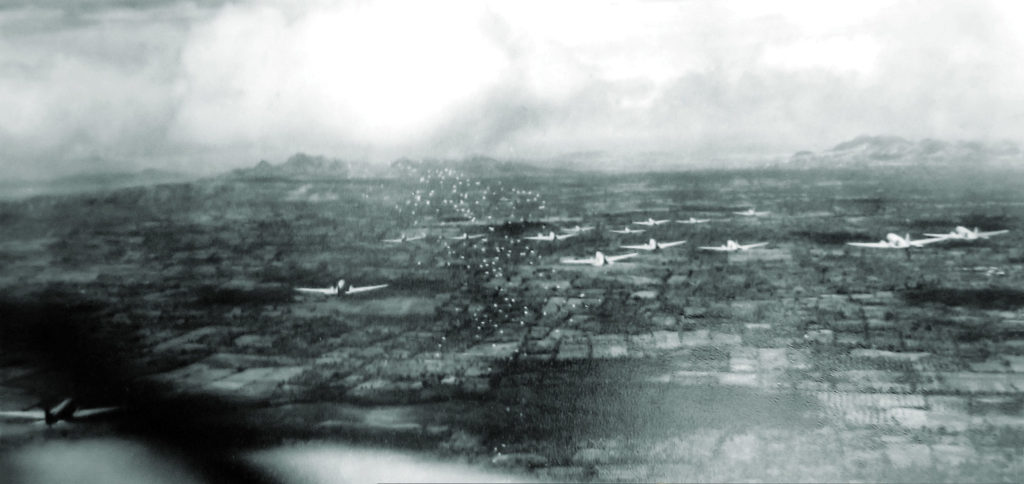
This was all unknown to the Americans, whose early intelligence suggested the Japanese were evacuating the city. More recent reports from local guerrillas, however, reported the construction of urban strongpoints: fortified buildings, emplaced landmines, and barricaded road intersections. Eichelberger dismissed the updates. “The guerrilla reports make me laugh,” he wrote. “The report tonight is that Manila is being burned by the Japanese, and yet I can look right down into the town and see lights and one little fire.”
Eichelberger ordered the 11th Airborne into the city.
At Tagaytay Ridge, Swing tapped his paratroopers to lead the charge since the glidermen had been fighting for four days without rest. With the bulk of his supplies still at Red Beach, Swing pressed every available man into service. The band’s musicians hauled cargo ashore and operated bulldozers to assist engineers in grading beach access roads. The division’s clerks, cooks, and parachute riggers served as stevedores, unloading rations and tons of crated artillery, mortar, and rifle ammunition as well as grenades, medical supplies, and radio batteries. The headquarters’ finance staff, along with members of the adjutant general’s office, humped the artillery and mortar shells forward. Five hundred local laborers were paid to help organize the growing stockpiles.
More improvisation was required to get the troops the 30-odd miles to Manila. Five hundred troopers of the 2nd Battalion would depart first in a few jeeps and 17 cargo trucks. Two jeeps towing 75mm pack howitzers and two tank-like, pug-nosed M8 self-propelled 75mm howitzers brought up the rear. They’d drive until they made enemy contact, at which point the trucks would go back for the next group, which was heading north on foot.
The convoy made it 22 miles to the village of Imus, where the Japanese had blown the main bridge over the 80-foot-wide Imus River. A fierce skirmish erupted over a secondary crossing, with an M8 clanking forward to hurl 75mm shells into the enemy. Following an infantry assault, the paratroopers continued forward. Eichelberger and Swing were both up front, urging speed. Eichelberger later wrote, “Things were bogged down a bit, so we jazzed it up.”
The troopers kept moving, pinning down any resistance while other units flanked the skirmishes to keep moving toward the capital. Six miles south of the city center, in the suburb of Parañaque, the point squad was stopped cold. The Japanese had fortified the last bridge into the capital with several pillboxes. Up the coast, troopers could see a glowing conflagration as Manila’s port became engulfed in flames. Iwabuchi had ordered the demolition of the docks and fuel storage depots and the fires had set bordering houses aflame.
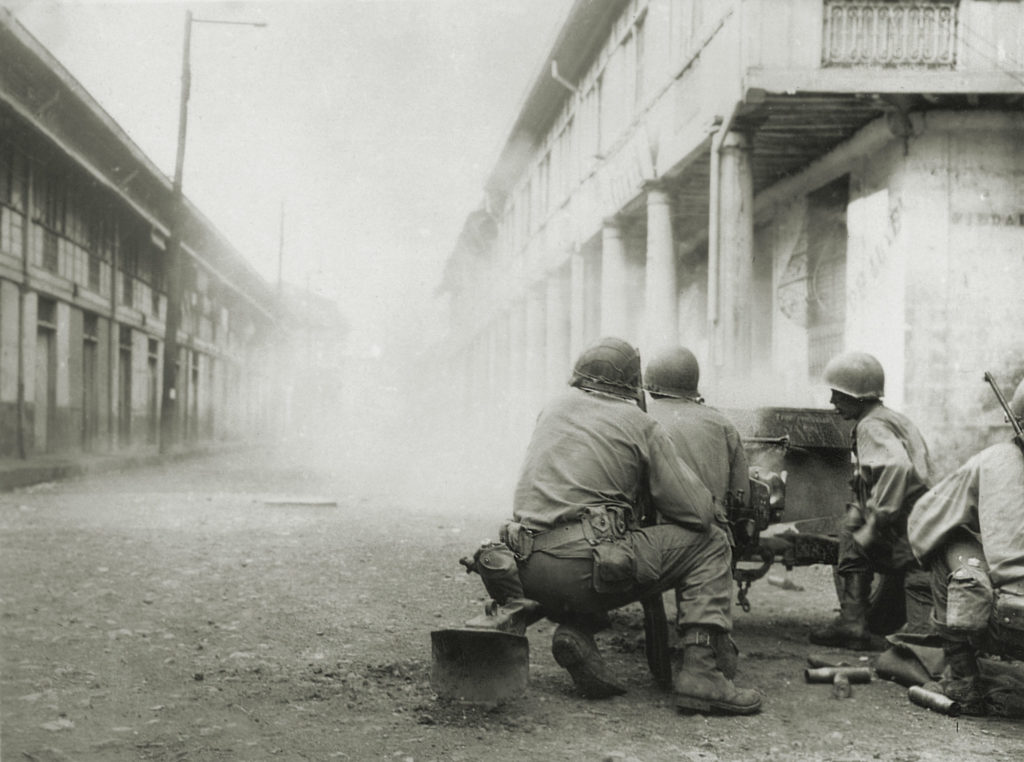
The Japanese holding the city were now caught in a vice, with Swing’s division poised to the south, and two of Krueger’s closing from the north. The stage for a tragedy of unimaginable horror was set.
The next morning, February 5, 1945, a dawn assault got the paratroopers across the bridge. But by sunset they had only gained a few blocks and were digging in to avoid flying shrapnel from incessant artillery. They had run into Iwabuchi’s Genko Line, a fortified belt approximately two and a half miles deep, starting at Manila Bay’s shoreline and running east five miles or so to high ground at Laguna De Bay. An estimated 4,000 Japanese manned more than 150 light, medium, and heavy-caliber anti-aircraft guns bolstered by dozens of dug-in howitzers. Hundreds of pillboxes covered open fields and road intersections with machine guns and rifles.
Krueger’s 1st Cavalry Division dismissed the report by Eichelberger and Swing that their forces had made a toehold in the capital. Instead, Krueger’s command claimed that they had beat their rivals by six hours. Swing later argued in his own favor, but U.S.-issued maps showed that his men, while certainly in the suburbs, were still four miles south of the pre-war city limits.
The approach to Manila was over, but far worse was yet to come. The ensuing battle for the city would last for several weeks of bitter street fighting, ending on March 3. As one trooper lamented, “From now on our advance was not measured in miles, it was measured in yards.” By the time the city fell, more than 100,000 citizens were dead and Manila, once hailed as the Pearl of the Orient, was reduced to rubble. H
James M. Fenelon is a former paratrooper and author of Four Hours of Fury, the story of the 17th Airborne Division’s jump across the Rhine River. His next book, Angels Against the Sun, chronicles the 11th Airborne Division in the Pacific and was published in April 2023.

